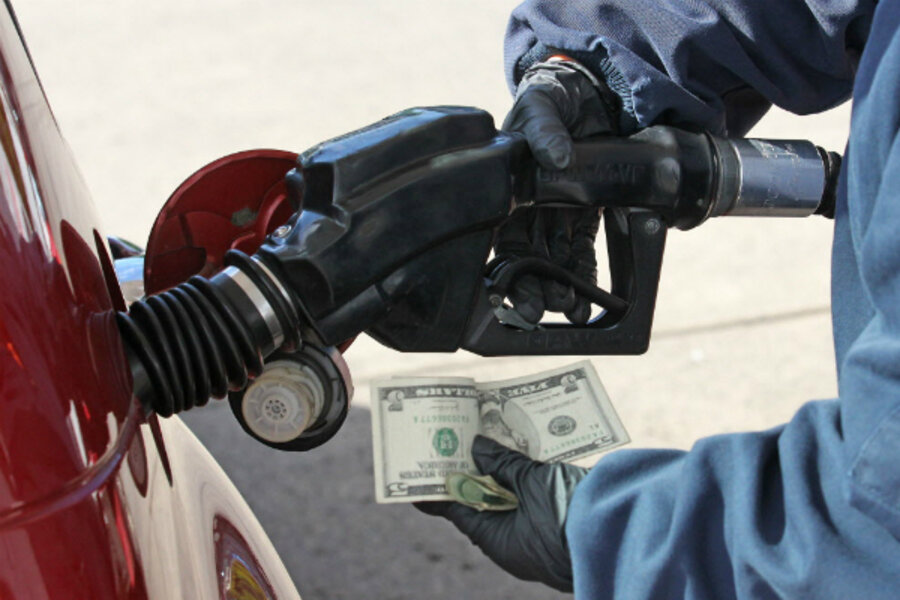Memorial Day weekend: (almost) no sticker shock on gas prices
| NEW YORK
Americans hitting the highways this Memorial Day weekend will have no trouble finding reasonably priced gasoline – as long as they don’t live in the upper Midwest, where prices have soared by as much as 68 cents a gallon in the past two weeks.
Aside from gasoline pumps in such places as Minnesota and North Dakota, gas prices are about the same as at this time last year, averaging $3.66 a gallon nationwide, according to AAA, the national motorists club. In some states, such as South Carolina and Tennessee, the price is in the $3.20 range.
Relatively flat gasoline prices at the start of what is considered the summer driving season will help the wallets of 31.2 million Americans whom AAA expects to use cars to travel to their weekend destinations. But gasoline prices go beyond the Memorial Day weekend: They have a subtle psychological effect on American consumers, because gasoline is a commodity for which buyers often track prices. If gasoline prices are soaring, consumers may hold back on other purchases; if prices are falling, they may be more positive.
“If gasoline were to hit $4 a gallon, it would be a terrible thing,” says Dennis Jacobe, the Washington-based chief economist at the Gallup Organization. “For a weak economy, it would be very bad.”
Gallup’s consumer confidence polling is finding that people are more optimistic. However, Mr. Jacobe says that upbeat attitude has more to do with rising home values, not flat gasoline prices. Many Americans will opt to spend more money on their homes this summer instead of taking expensive vacations, he predicts.
Indeed, a AAA survey released Wednesday found that travel this coming weekend is expected to be down 0.9 percent from last year. But most of the drop in travel is the result of an expected 8 percent decline in air travel.
“American travelers are experiencing fee fatigue and frustration with everything from higher fares to airport security,” says Robert Darbelnet, president and CEO of AAA, in a statement. “As a result, many are choosing road travel in higher numbers due to the lower cost and convenience it offers.”
Prices appear to have peaked in February, when gasoline cost an average $3.79 a gallon. Fuel prices then fell until April, when they started rising again. In the past two months, gasoline prices have gone up 15 cents a gallon, while the price of crude oil is up about 24 cents a gallon, according to John Felmy, chief economist at the American Petroleum Institute in Washington.
Another key component at the pump, ethanol, which is mostly made from corn, has jumped in price by about 50 cents a gallon since the beginning of the year. That run-up in price adds another five cents a gallon to the price of gasoline blended with 10 percent ethanol, Mr. Felmy estimates.
Although the rising price of ethanol is not responsible for the sharp price hike in the Midwest, consumers in that region will be paying higher prices at the pump. According to AAA, on Wednesday North Dakotans paid a record $4.24 a gallon. Minnesotans paid a record $4.28 a gallon. Iowa, at $4.02 a gallon, was close to a record price.
Part of the reason for the run-up is a lot of work on refineries, explains Tom Kloza, director of editorial content at the Oil Price Information Service in Wall, N.J. “It was more than normal,” he says. “So, it’s like Parkinson’s law: When you schedule maintenance work on six out of 15 refineries, you can expect to have another two that are shut down for unanticipated reasons.”
Some Midwest refineries were shut because they are being reconfigured so they can process heavy, sour crude coming from Canada. That oil is selling at a considerable discount to sweet crude oil pumped in the Middle East, says Mr. Kloza.
The good news is that fuel wholesalers have started to ship gasoline to the states that have high prices, Kloza says, and some refineries are coming back on line.
“The spike is over,” he says.
Prices in other parts of the US may also start to fall as well this summer. Demand for gasoline is falling, the combined result of a relatively weak economy and better fuel economy for vehicles. Last year, gasoline prices bottomed out at the beginning of July. This year it might be the end of June, or early July again, says Avery Ash, manager of regulatory affairs for AAA in Washington.
“We think the low point will be $3.20 to $3.40 a gallon this summer,” says Mr. Ash.





